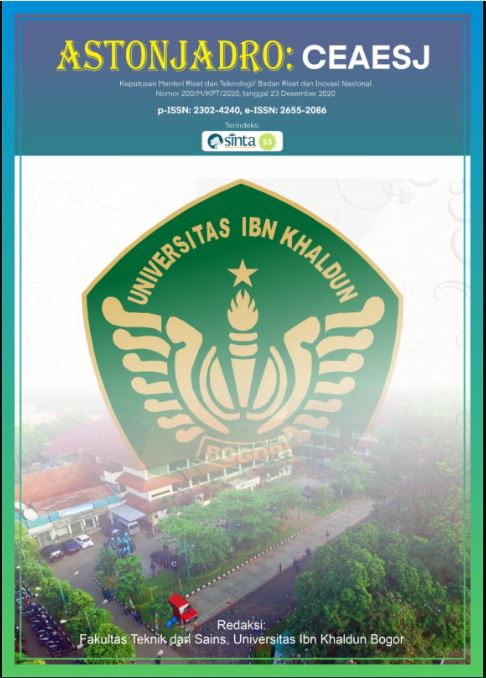ANALYSIS FACILITIES PEDESTRIAN AND BICYCLE LANE LANES AS FACILITIES MODA TRANSPORTATION PUBLIC OF INTEGRATION IN BEKASI KOTA
DOI:
https://doi.org/10.32832/astonjadro.v11i2.4091Keywords:
pedestrian fasilities, growth, performance, planning, provide services.Abstract
Analysis facilities pedestrian and bicycle lanes as facilities integration modes of public transport in the city of bekasi (Case Study: Bekasi Terminal and BTC Bus Stop). The city of bekasi located in west java province which has an area of areas 210,49 km2. The city central being as business and commerce , and activities services so that be an attraction for newcomers to look for a job and to shelter Terminal bekasi and bus stops btc is located in kecamatan bekasi timur , in the city of bekasi the rate of population growth in the year 2019 as much as 1.4 %. Walking is a mode of transportation. All buildings are provided for pedestrians in order to provide services to pedestrians so as to improve the smoothness, safety and comfort of pedestrians. The purpose of this study is to analyze the performance of pedestrian facilities in Bekasi Terminal and BTC bus stops. The method used is conducting direct field surveys and data processing using Microsoft Excel. The results of the author's research include the minimum width of the sidewalk in 2020 and 2025 of 1.5 - 1.6 meters and the service level of pedestrian facilities is classified as A, which means that pedestrians can walk freely, including being able to determine the direction of walking freely, at speed. relatively fast without causing interference between pedestrians. The existing condition of sidewalks in 2020, namely there are several obstacles for pedestrians such as the presence of street vendors, several motorbikes parked carelessly, buying and selling activities in markets close to Bekasi Terminal and limited integration facilities around the place. Planning that the authors do is to increase the width of the sidewalk to 3 meters, arrangement of closed drainage on the shoulder of the road, and the addition of street lighting facilities.
References
Bagus, H., Ira, B, P, W., Priyantha, W., 2013, Pedestrian Facility Service Analysis, Civil Engineering Infrastructure Electronic Scientific Journal, Vol. 2 No. 1, Denpasar.
C. Jotin Khisty and B. Kent Lall., 2003, Fundamentals of Transportation Engineering. 3rd ed, Erlangga Publisher, Jakarta.
Director General of Highways,1999, Guidelines for Planning Pedestrian Paths on Public Roads, Publisher Bina Marga, Jakarta.
Director General of Highways, 1991, Technical Guidelines for Planning, Publisher Bina Marga, Jakarta.
DEPARTMENT OF PUBLIC WORKS DIRECTORATE GENERAL OF BINA MARGA DIRECTORATE OF ENGINEERING DEVELOPMENT Regarding Planning Prosedures for Pedestrian Facilities in Urban Areas No. 011/T/Bt/1995.
Directorate General of Land Transportation No. 271 of 1996 concerning Technical Guidelines for the Engineering of Public Passenger Vehicles.
Directorate General of Land Transportation No.31 of 1993 concerning road transportation terminals
Don Gaspar N. da Costa, & Stephanus Ola Demon. (2018). Integrated Pedestrian Facilities Management Strategy.
East Bekasi City Central Bureau of Statistics, (2019). Bekasi City in Numbers Bekasi In Figures 2019 (2 ed). Central Bureau of Statistics for the City of East Bekasi.
Hadi, RT (2018). Design and Development of the Pedestrian Paths Model 122.
I Gst Bagus Hendrayana, et al. (2013). Pedestrian Facility Analysis.
ITDP Indonesia. (2019). Pedestrian Facility Design Guide: DKI Jakarta 2017-2020 (2nd ed). ITDP Indonesia.
J Akbardin, D Parikesit, B Riyanto, AT Mulyono, S Syaiful. 2020. MODELLING OF TRIPS ASSIGNMENT ANALYSIS FOR ROADS NETWORK SYSTEM BASED ON TRANSPORTATION NEEDS OF EXSPORT COMMODITY. ARPN Journal of Engineering and Applied Sciences 15 (21), 2463-2470.
Pedestrian path space requirements (PM. PU. No. 03/PRT/M/2014)
Muhlas Hanif Wigananda, 2012, Performance Analysis of Pedestrian Tracks in Surabaya City (Case Study: Jl. Pemuda), Final Project, Sepuluh Nopember Institude of Technology.
Minister of Transportation. (1995). Decree of the Minister of Transportation. Minister of Transportation.
MKJI. (1997). Highway Capacity Manual Project (HCM). PT. Bina Karya Persero.
MAM Alfanani, S Syaiful, T Murtejo. 2021. Studi Analisa Rencana Pembangunan Kawasan Berorientasi Transit (TOD) di Sentul City. Seminar Nasional Ketekniksipilan, Infrastruktur dan Industri Jasa Konstruksi (KIIJK) 1(1).127-134. (Indonesian).
Nurdiansyah, D. (2019). Arrangement of Intermodal Integration Facilities at Sukabumi Station. 5.
PUPR No. 02 of 2018.
PP RI Number 79 concerning Road Traffic and Transportation Network. (2013).
Regulation of the Minister of Public Work Number: 03/Pr/M/2014/2011. Regarding Guidelines for Planning, Provision, and Utilization of Pedestrian Network Infrastructure and Facilities in Urban Areas.
RI Number concerning Road and Traffic and Transportation Network.
RI Law Number 22 Year 2009 concerning Traffic and Road Transportation. (2009). Law of the Republic of Indonesia Number 22 of 2009 concerning Road Traffic and Transportation.
SPM, Provision of Bicycle Infrastructure, 2018.
S Syaiful, Y Pratama, 2019. SUSTAINABLE STUDIES ABOUT GENERAL PUBLIC TRANSPORT PERFORMANCE IN THE CITY OF BOGOR. ARPN Journal of Engineering and Applied Sciences 14 (18), 3241-3247.
S Syaiful. 2017. ENGINEERING MODEL OF TRAFFIC AND TRANSPORTATION SAFETY WITH PATTERN OF COOPERATION BETWEEN SUSTAINABLE REGION IN BOGOR. MATEC Web of Conferences 138 (07008), 1-9.
S Syaiful, A Fadly. 2020. ANALYSIS OF THE EFFECTIVENESS OF BUS SERVICES OUTSIDE OF CAMPUS IPB DRAMAGA BOGOR. ASTONJADRO: CEAESJ 9 (2), 173-186.
S Syaiful. 2017. EFEKTIFITAS PENGGUNAAN HALTE BIS KOTA DI WILAYAH SURAKARTA. Simposium Nasional RAPI XVI-2017 FT UMS 156 (2017), 131-138. (Indonesian).
Sweetly, M., James, A, T., and Theo, K, S., 2015, Analysis of Sidewalk Service Levels in terms of Flow Rate on Jalan Sam Ratulagi Manado for Segments of Jalan Rs Siloam – Zero Point Monument Manado City, Journal Sipil Statik, Vol. 3 No.2, Manado.
UU No. 38 of 2004 concerning Road.
Downloads
Published
How to Cite
Issue
Section
License
Paper submitted to ASTONJADRO is the sole property of the Astonjadro Journal. Unless the author withdraws the paper because he does not want to be published in this journal. The publication rights are in the journal Astonjadro.ASTONJADRO
LICENSE
This work is licensed under a Creative Commons Attribution-ShareAlike 4.0 International License.
Based on a work at http://ejournal.uika-bogor.ac.id/index.php/ASTONJADRO













